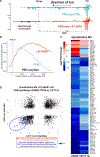Multi-omics and biochemical reconstitution reveal CDK7-dependent mechanisms controlling RNA polymerase II function at gene 5'- and 3' ends
- PMID: 40570372
- PMCID: PMC12329788
- DOI: 10.1016/j.celrep.2025.115904
Multi-omics and biochemical reconstitution reveal CDK7-dependent mechanisms controlling RNA polymerase II function at gene 5'- and 3' ends
Abstract
CDK7 regulates RNA polymerase II (RNAPII) initiation, elongation, and termination through incompletely understood mechanisms. Because contaminating kinases prevent reliable CDK7 analysis with nuclear extracts, we reconstitute RNAPII transcription with purified factors. We show that CDK7 inhibition slows and/or pauses RNAPII promoter-proximal transcription and suppresses re-initiation, and these effects are Mediator and TFIID dependent. Similarly in human cells, CDK7 inhibition reduces transcriptional output by suppressing RNAPII initiation and/or re-initiation. Moreover, widespread 3' end readthrough transcription occurs in CDK7-inhibited cells; mechanistically, this results from rapid nuclear depletion of RNAPII elongation and termination factors (e.g., DSIF, Integrator, NELF, SPT6, PPP1R10/PNUTS, and SCAF8), including high-confidence CDK7 kinase targets. Collectively, these results define how CDK7 governs RNAPII function at gene 5' ends and 3' ends and reveal that nuclear abundance of elongation and termination factors is kinase dependent. Because 3'-readthrough transcription is commonly induced during stress, our results further suggest that regulated suppression of CDK7 activity enables this transcriptional response.
Keywords: 3’-readthrough transcription; CDK7; CP: Molecular biology; Mediator; PRO-seq; RNA polymerase II; TFIID; in vitro transcription; promoter escape; promoter-proximal pausing; proteomics; re-initiation.
Copyright © 2025 The Author(s). Published by Elsevier Inc. All rights reserved.
Conflict of interest statement
Declaration of interests D.J.T. received some funding support for this project from Syros Pharmaceuticals, Inc. R.D.D. is a founder of Arpeggio Biosciences.
Figures







Update of
-
Multi-omics and biochemical reconstitution reveal CDK7-dependent mechanisms controlling RNA polymerase II function at gene 5'- and 3'-ends.bioRxiv [Preprint]. 2025 Jan 8:2025.01.08.632016. doi: 10.1101/2025.01.08.632016. bioRxiv. 2025. Update in: Cell Rep. 2025 Jul 22;44(7):115904. doi: 10.1016/j.celrep.2025.115904. PMID: 39829884 Free PMC article. Updated. Preprint.
References
MeSH terms
Substances
Grants and funding
LinkOut - more resources
Full Text Sources
Miscellaneous

